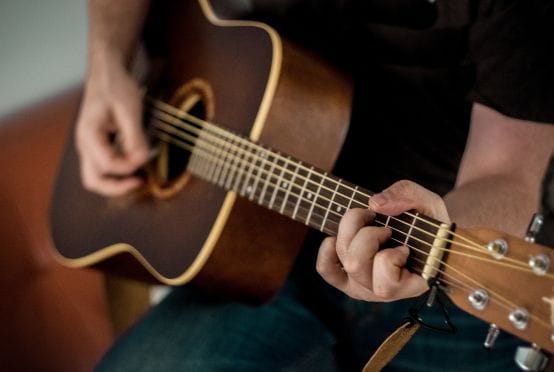Choosing the right size guitar is crucial for beginners, especially younger players, to ensure comfort and optimal learning. It’s essential to balance factors like age and physical stature. This article explores the challenges and tradeoffs in selecting the appropriate guitar size, emphasizing their impact on learning and enjoyment.
Guitar Size Chart by Age
| Age | Player Height | Guitar Size |
| 4-6 | 31″ -46″ | 1/4 Size |
| 5-8 | 43″ -55″ | 1/2 Size |
| 7-11 | 50″ -60″ | 3/4 Size |
| 11-Adult | 60″ + | Full Size |
Why Choose the Right Size Guitar?
Playing a guitar that fits well enhances comfort, reduces strain, and promotes better technique. By choosing an appropriate size, players can avoid discomfort and potential injuries, leading to a more enjoyable learning experience. However, balancing factors such as age, arm length, and hand size is crucial.
Younger players may need smaller guitars for easier handling, while older beginners might benefit from larger sizes for better sound quality. It’s important to consider these tradeoffs when selecting a guitar, as the right size significantly impacts a player’s progress and overall enjoyment of music.

Factors to Consider When Choosing Guitar Size
Several factors play a role in determining the right guitar size, including the player’s height, arm length, and hand size. Choosing a guitar that matches these physical attributes ensures ergonomic comfort and facilitates easier learning.
However, balancing these factors can be challenging; taller individuals may need longer-scale guitars for reach, while shorter players might prefer smaller sizes for maneuverability. It’s crucial to consider these tradeoffs to optimize playing comfort and technique development at every age level represented in the Guitar Size Chart.
Guitar Size Chart by Age
Here’s a comprehensive guitar size chart categorized by age to help you select the perfect instrument for each stage of learning.
Ages 3-5: Quarter-Size Guitar (30″ Total Length)
For children aged 3-5 years, a quarter-size guitar, approximately 30 inches in total length, is recommended. This smaller size ensures that young children can comfortably hold and play the instrument, fostering early musical interest and development.
Ages 6-9: Half-Size Guitar (34-36″ Total Length)
Children aged 6-9 years typically benefit from a half-size guitar, ranging from 34 to 36 inches in total length. This size allows for easier handling and maneuverability, promoting better posture and technique development during the early stages of learning.
Ages 10-12: Three-Quarter Size Guitar (36-39″ Total Length)
Pre-teens aged 10-12 often find a three-quarter size guitar, ranging from 36 to 39 inches, comfortable to play. This size offers increased sound projection and fretboard space, facilitating a smoother transition to larger instruments while ensuring continued ease of play.
Teenagers and Adults: Full-Size Guitar (40-42″ Total Length)
Teenagers and adults typically use a full-size guitar, ranging from 40 to 42 inches in total length, for optimal playability. This standard size provides enhanced sound quality, broader fretboard spacing for complex chord formations, and greater resonance, catering to more advanced playing techniques and musical styles.
Balancing factors such as age, physical stature, and musical aspirations is key when selecting the right guitar size. Each size offers its own advantages and considerations, influencing both comfort and skill development. By choosing the appropriate size based on these factors, players can maximize their enjoyment and progress in learning the guitar at every age level.

Tips for Trying Out Guitars
Before purchasing a guitar, consider these tips to ensure the instrument feels comfortable and suits your playing style.
- Visit a Music Store: Try out guitars in person to feel their size and weight.
- Check Reach and Comfort: Ensure you can reach all frets comfortably and strum without strain.
- Hold the Guitar: Test different playing positions to find one that feels natural.
- Consider Sound Quality: Balance size with sound projection for your desired music style.
- Seek Expert Advice: Consult with music store staff or a guitar teacher for guidance.
Finding the right guitar involves balancing comfort, playability, and sound quality. Each player’s preference and physique influence the choice, ensuring an enjoyable and effective learning experience at any age.
Conclusion
Selecting the correct guitar size based on age enhances learning comfort and promotes long-term enjoyment of playing music. By considering factors like physical dimensions and playing preferences, players can optimize their musical journey from the outset, ensuring both comfort and skill development are maximized for sustained enjoyment and progress.
FAQs
Q1: What happens if I choose the wrong size guitar for my child?
A1: Choosing the wrong size guitar can lead to discomfort, difficulty playing, and even discourage interest in learning. It’s crucial to match the guitar size to your child’s age and physical stature for optimal comfort and enjoyment.
Q2: Can adults use smaller guitars meant for children?
A2: While adults can technically play smaller guitars, they may find them less comfortable due to smaller fretboards and reduced resonance. Full-size guitars are generally recommended for adult players to ensure optimal playability and sound quality.
Q3: How do I know if a guitar size is right for me or my child?
A3: Test different guitar sizes in person to assess comfort, reach, and sound quality. Ensure you can comfortably hold and play the instrument without strain. Consulting with a music store expert or guitar teacher can also provide valuable guidance.
Q4: What if my child grows quickly?
Should I buy a larger size to accommodate growth?
A4: It’s essential to balance current comfort and future growth. Buying a slightly larger guitar to accommodate growth can be beneficial, but ensure it’s not too large to hinder current learning and enjoyment.
Q5: Are there specific recommendations for different music styles based on guitar size?
A5: Generally, larger guitars offer better sound projection and sustain, making them suitable for styles requiring a fuller sound, like classical or acoustic rock. Smaller guitars are often preferred for genres needing faster fretboard navigation, like folk or blues.